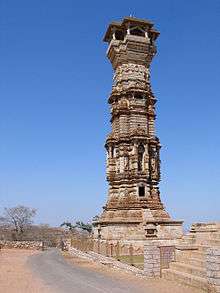Stambha

Kirti Stambh at Chittorgarh fort in Rajasthan, India
Stambha (also spelled as Skambha) - in the context of Hindu mythology, is believed to be a cosmic column. It is believed that the stambha functions as a bond, which joins the heaven (Svarga) and the earth (prithvi). A number of Hindu scriptures, including the Atharva Veda, have references to stambha. In the Atharva Veda, a celestial stambha has been mentioned, and that has been described as a scaffold, which supports the cosmos and material creation.
In Indian architecture, different types of Stambhas have been mentioned and they serve different purpose, including the following:
- Flagstaffs, called dhvaja stamnhas, are placed opposite the main shrine, on an axis with the main deity.
- Kirttistambhas, erected to commemorate victories.
- Most well known stambhas of India are the Pillars of Ashoka erected during the reign of Ashoka, which bear different types of royal edicts.
References
- Dictionary of Hindu Lore and Legend (ISBN 0-500-51088-1) by Anna Dallapiccola
External links
| Wikimedia Commons has media related to Stambhas. |
This article is issued from Wikipedia - version of the 10/21/2016. The text is available under the Creative Commons Attribution/Share Alike but additional terms may apply for the media files.
